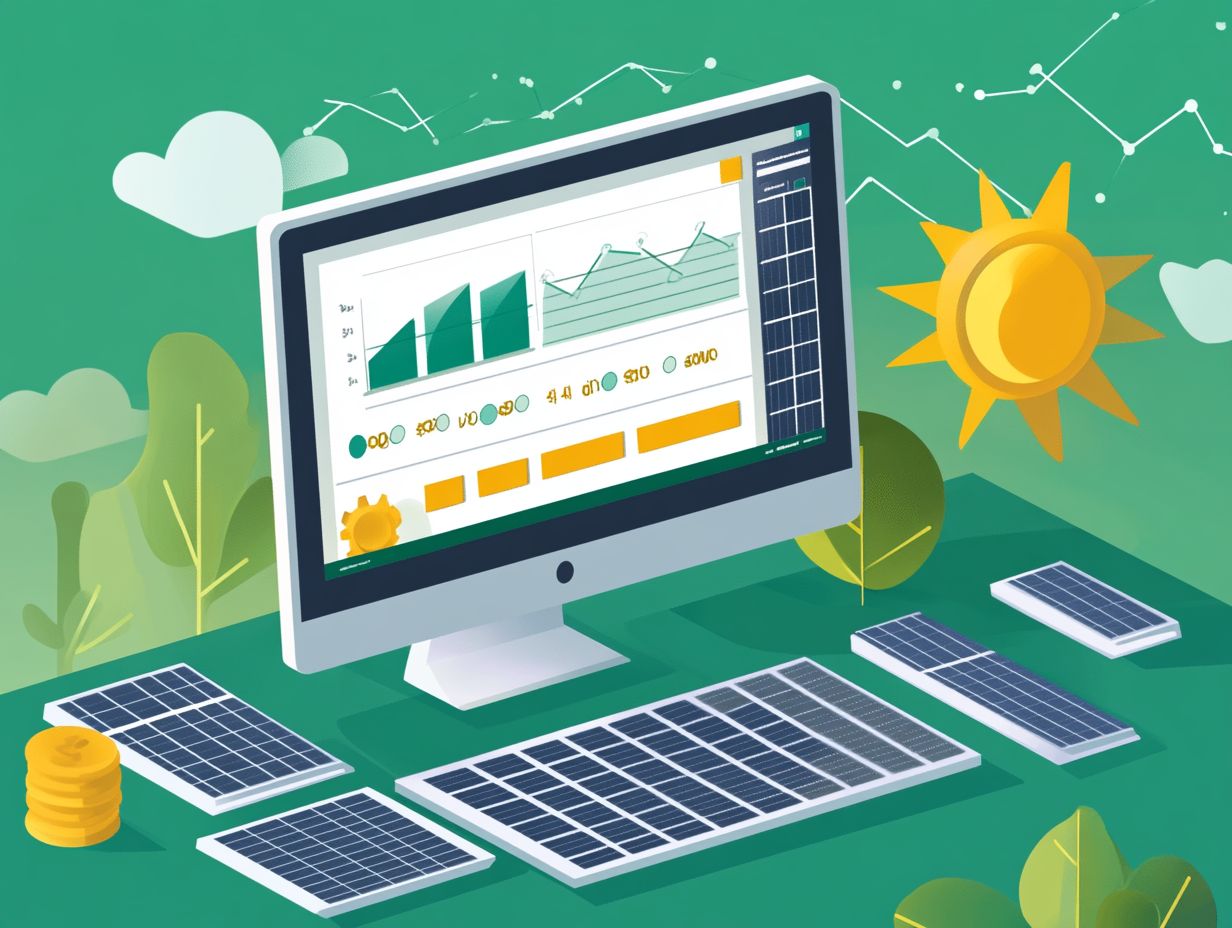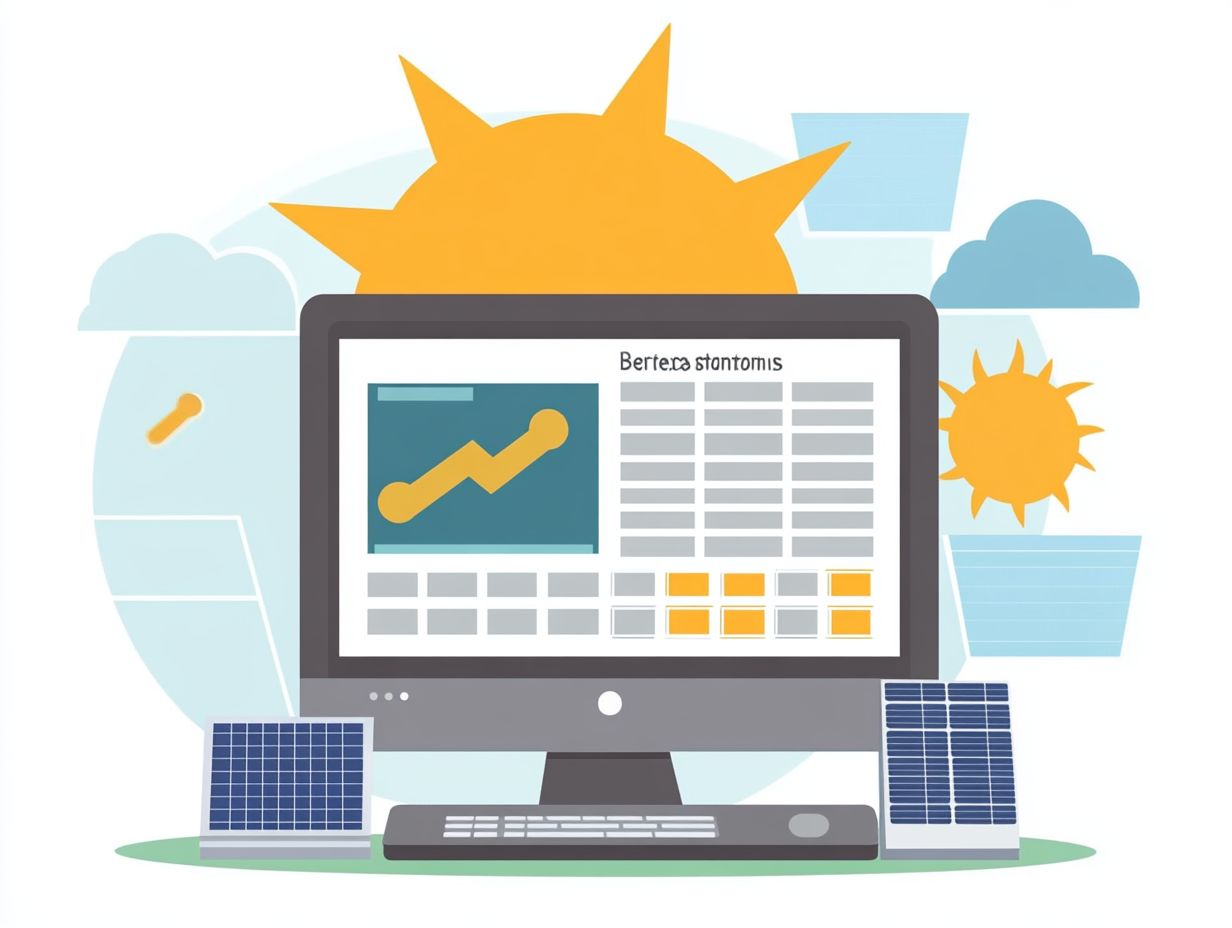Contents
- 1 How Solar Cost/Benefit Calculators Work
- 2 Advantages of Solar Cost/Benefit Calculators
- 3 Key Factors to Consider Before Using a Solar Cost/Benefit Calculator
- 4 Best Solar Cost/Benefit Calculators Available
- 5 Tips for Using a Solar Cost/Benefit Calculator Effectively
- 6 Frequently Asked Questions
- 6.1 What is a Solar Cost/Benefit Calculator?
- 6.2 Why should I use a Solar Cost/Benefit Calculator?
- 6.3 How accurate is the information provided by a Solar Cost/Benefit Calculator?
- 6.4 Can a Solar Cost/Benefit Calculator help me save money?
- 6.5 Are all Solar Cost/Benefit Calculators the same?
- 6.6 Steps to Use a Solar Cost/Benefit Calculator
What is a Solar Cost/Benefit Calculator?
A Solar Cost/Benefit Calculator helps users understand the financial implications of solar energy investments.

A Solar Cost/Benefit Calculator is an incredibly useful tool for you to figure out the financial side of investing in solar energy, whether you’re a homeowner or a business owner.
By plugging in different numbers, like installation costs, energy savings, tax credits, and financial incentives, you can get a clear idea of your potential return on investment and the economic benefits of solar.
This calculator considers important factors like how much sunlight your area gets, which affects energy production and electricity generation, as well as any ongoing maintenance costs you might face over the solar panel lifespan.
It also looks at various solar financing options, such as solar lease options and solar purchase agreements, so you can see how loans or leases could impact your overall expenses.
By factoring in things like potential tax credits, solar rebates, and rising utility rates, this handy tool gives you a well-rounded view of the long-term benefits, helping you make an informed decision.
So, using a calculator like this can really help you understand how solar energy can lead to some serious savings and positive environmental impacts.
How Solar Cost/Benefit Calculators Work
Understanding how solar cost/benefit calculators work means diving into the calculations and data inputs that make them tick.
These calculators take various inputs, like system size, local utility rates, and energy efficiency metrics, to churn out useful information like the payback period, utility bill reduction, and overall savings.
By using advanced solar technology and clever financial modeling techniques, they give you a clear picture of the potential benefits of solar investments, including energy independence and financial savings, helping you make informed decisions.
U.S. Department of Energy (DOE). (2021). Solar Energy Technologies Office: Funding Opportunities. Link
Understanding the Calculations and Data Inputs
This section focuses on the key aspects that influence the effectiveness of a solar cost/benefit calculator.
The effectiveness of a solar cost/benefit calculator really hinges on how accurate its calculations are and the quality of the data you input.
You’ll want to consider essential components like installation costs, projected electricity savings, and system performance metrics that show how efficient the photovoltaic systems are.
With a little help from predictive analysis, these calculators can estimate your savings potential, including kilowatt-hour savings and energy cost savings, and point you toward the best solar financing options tailored to your unique energy needs.
To make your decision-making even easier, these calculators usually include various calculations related to energy consumption analysis, which can vary quite a bit depending on where you live.
For example, if you’re in an area that gets a lot of sunlight, you might see greater benefits compared to someone in a less sunny spot.
Also, don’t forget about regional incentives like tax credits, solar rebates, and net metering—they can significantly shift the cost-benefit equation, making solar installations a lot more financially appealing.
By comparing these local benefits with your personal energy use, you can get a clearer picture of the return on investment you might expect from going solar. This way, you can make more informed choices that are kinder to your wallet.
Advantages of Solar Cost/Benefit Calculators
This section highlights the various benefits of utilizing solar cost/benefit calculators.
Using a solar cost/benefit calculator comes with numerous benefits, especially when it comes to utility savings, energy payback time, and making a positive impact on the environment.
By getting a clear picture of the costs tied to solar panel installation, you can evaluate your return on investment and see just how much you could save on those pesky utility bills while tapping into renewable energy.
Plus, these calculators often highlight any available solar energy incentives, helping you to fully utilize tax credits and other financial perks, boosting your solar investment analysis.
Financial Savings and Environmental Impact

Using a solar cost/benefit calculator can save you some serious cash while also helping the environment. These calculators give you a clear picture of how solar investments can cut down your carbon footprint and lower those pesky utility bills.
By analyzing data on energy generation from solar technology, you’ll get a solid understanding of the potential energy savings and renewable energy credits, leading to a significant drop in your overall energy consumption and expenses over time.
These handy tools let you track your renewable energy credits, showing you exactly how each kWh of solar energy you produce contributes to a greener planet.
When you calculate your projected energy output and efficiency ratio, you might be surprised by not only how much you could save each month but also the impact on reducing greenhouse gas emissions, helping you align with global sustainability goals.
And don’t forget, many places offer solar power incentives for going solar, so those added financial benefits can boost your savings even more. It makes solar energy a smart choice for both your wallet and the planet.
Key Factors to Consider Before Using a Solar Cost/Benefit Calculator
Before you dive into the results of a solar cost/benefit calculator, it’s important to think about a few factors that could impact your final outcome, like where you live, solar module efficiency, and how much energy you use.
Things like local electricity rates, the timeline for installation, and the solar financing options available to you, including an amortization schedule, can all affect your project costs and how feasible solar adoption really is.
Getting a good grasp of these factors will help you accurately interpret the calculator’s results and make well-informed decisions.
Influential Variables: Location and Energy Usage
Your location and energy usage patterns are key players in figuring out how effective a solar cost/benefit calculator will be for you.
Things like the climate in your area and how efficiently solar panels work can really impact your energy production estimates and consumption. Plus, local electricity rates can either boost your savings or leave you wanting.
It’s also crucial to understand other factors, like installation costs, solar project costs, and system performance, if you want to nail down accurate financial projections and future savings.
Don’t forget about the direction your roof faces, how much sunlight it gets, and those seasonal changes. All of these elements shape your energy consumption habits, which can heavily influence your investment decisions in solar power systems.
Knowing when you use the most energy can help you customize your solar solutions to get the most bang for your buck. As you navigate this complex landscape, having precise data on your energy use patterns is essential for crafting your personal solar plan.
This strategy not only maximizes your energy efficiency but also boosts your overall return on investment and potential property value increase, making solar installations even more attractive and feasible in the long run.
Best Solar Cost/Benefit Calculators Available
When you start checking out the top solar cost/benefit calculators out there, you’ll discover a mix of features, reviews, and pricing options that fit different needs.
These calculators aim to make your decision-making process smoother by giving you comprehensive data insights, like cost projections, financial incentives, solar tax benefits, and energy savings analysis.
Plus, keeping an eye on current solar market trends and technology advancements can really help you pick the best tool for your solar investment journey.
Features, Reviews, and Pricing

The features, reviews, and pricing of different solar cost/benefit calculators can really vary, impacting how useful they are for you. Some calculators dive deep into financial modeling, while others are all about being user-friendly.
By checking out user reviews and comparing prices, you can find a solar calculator that fits your needs and expectations when it comes to functionality and accuracy in projections, including solar performance ratio.
You’ll find that people often rave about calculators with intuitive designs, making it easy for even beginners to sift through complex information. Accuracy in solar panel performance metrics is super important, as you want to rely on trustworthy estimates for your investment.
Explore these calculators to find the perfect fit for your solar investment journey!
User feedback often emphasizes the effective integration of local data by these tools, giving you personalized insights based on your geographic location and energy consumption patterns, enhancing solar resource assessment.
In the end, choosing the right solar power calculator can really shape your decision-making process, helping you understand the costs involved while appreciating the long-term benefits of investing in solar technology.
Tips for Using a Solar Cost/Benefit Calculator Effectively
To get the most out of your solar cost/benefit calculator, it’s beneficial to follow these practical tips to maximize accuracy and really understand your results, ensuring thorough solar investment analysis.
Start by inputting your data carefully—make sure your installation costs, energy consumption figures, and other relevant metrics, such as solar capacity, are spot on.
Getting to know how the calculator works can also help you interpret the results better, making it easier for you to make informed decisions based on financial benefits, demand charges, and long-term savings potential.
National Renewable Energy Laboratory (NREL). (2015). Best Practices in PV System Installation. Link
Enhancing Accuracy and Interpreting Results
Maximizing accuracy in your solar calculator results is key for effective investment and comprehensive cost analysis.
When you ensure that all your inputs reflect your actual energy usage and installation costs, you’ll gain a clearer understanding of your potential return on investment.
This clarity helps you make informed decisions about installing solar panels, considering solar panel prices and the financial incentives available to you.
Accurate data inputs not only influence individual calculations but also shape your overall solar investment strategy.
One common mistake many people make is underestimating their energy consumption patterns, which can give them an inflated sense of potential solar energy savings.
Also, if you neglect to account for fluctuating energy prices and electricity rates, your projections might be skewed, making the investment seem more favorable than it actually is.
By carefully reviewing all variables, including installation fees and maintenance costs, you can dodge these pitfalls and make sure your solar calculator becomes a reliable tool in your financial planning arsenal.
Frequently Asked Questions
What is a Solar Cost/Benefit Calculator?

A Solar Cost/Benefit Calculator is an online tool that helps individuals estimate the cost and benefits of installing a solar panel system on their property.
It takes into account factors such as location, energy usage, and available incentives to provide an accurate cost and savings analysis, including solar energy savings and benefit analysis.
Why should I use a Solar Cost/Benefit Calculator?
A Solar Cost/Benefit Calculator can help you determine if investing in a solar panel system is a financially sound decision for your specific situation.
It takes into account various factors that affect the cost and savings of going solar, including solar financing options and tax credits, giving you a better understanding of the potential benefits.
How accurate is the information provided by a Solar Cost/Benefit Calculator?
The accuracy of a Solar Cost/Benefit Calculator depends on the data and assumptions used to calculate the results.
However, most calculators use current market data and constantly update their algorithms to provide the most accurate estimates possible, including energy production estimates and system performance.
Can a Solar Cost/Benefit Calculator help me save money?
Yes, a Solar Cost/Benefit Calculator can help you save money by estimating your potential cost savings over time. It takes into account factors such as electricity rates, tax incentives, and system costs to give you a realistic view of the financial benefits of going solar, such as utility bill reduction and energy independence.
Are all Solar Cost/Benefit Calculators the same?
No, different calculators may use different data and algorithms, resulting in slightly different outcomes. It is important to use a reputable and up-to-date calculator to get the most accurate results for your specific situation, including energy efficiency and renewable energy considerations.
Steps to Use a Solar Cost/Benefit Calculator
To use a Solar Cost/Benefit Calculator, you will need to provide information about your location, energy usage, and any relevant incentives or tax credits. The calculator will then use this information to estimate the cost and benefits of installing a solar panel system on your property, considering factors like solar panel lifespan and solar array costs.







